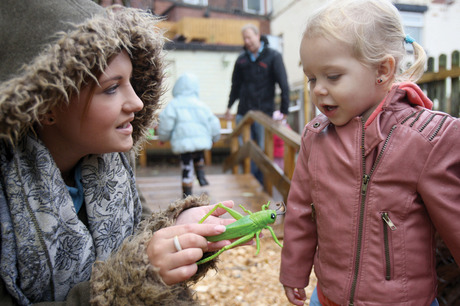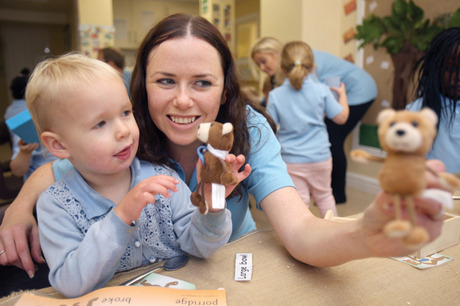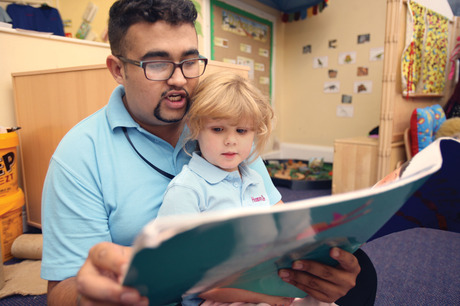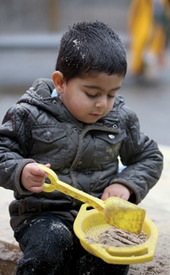
When he was young, my son used to love playing cops and robbers. One day, we ran out of the house, leapt into the car like Starsky and Hutch, and as we wheel-span out of the drive, he came out with the immortal words: ‘Stay your eyes on that car in front’. The episode has entered into family folklore; he has never lived it down.
‘Stay your eyes on that car in front’ is an example of a clever mistake. It is quite a creative thing to say – certai-nly not something that a seven-year-old is ever likely to have heard – but it is also not quite right. So why did he say it? What does it tell us about his knowledge of language at the time? And why does he not say things like this now that he is an adult?
The answers to these questions can tell us a lot about what children know about language at different points in development, and about how best to respond to them when they say things that sound a bit odd.
WHY DO CHILDREN MAKE CLEVER MISTAKES?
‘Stay your eyes on that car in front’ is not the kind of thing that a very young child would say. But clever mistakes have many forms1. Some involve putting a word like ‘stay’ in a sentence in which it does not belong. These mistakes can often look quite complicated, and it is not always easy to understand what is causing them.
Others, like ‘sheeps’, and ‘eated’, involve using a word with the wrong ending, and it is much easier to see where the child is going wrong. For example, a child who is saying ‘eated’ instead of ‘ate’ has added ‘–ed’ to ‘eat’ because they heard it used this way in words like ‘kicked’ and ‘jumped’.
These simpler kinds of mistakes can appear very early in children’s speech. For example, when parents are asked about the kind of mistakes their children make, some of them report mistakes like ‘eated’ and ‘drinked’ when their children are as young as two years old2.
Mistakes like ‘foots’ and ‘sheeps’ can appear even earlier than this. For example, in one study, a child called Ari was found to use the words ‘sheeps’ and ‘deers’ to describe collections of sheep and deer when he was only 20 months old. This was before he was even putting two words together to make simple sentences3.
Mistakes like ‘Stay your eyes on that car in front’ do not start appearing until children’s speech becomes a little more complicated, and persist well into the primary school years.
We owe a lot of our knowledge about these mistake to Melissa Bowerman, a linguist who kept detailed records of all the unusual things that her daughters Eva and Christy said between the ages of two and 11. She noted down these examples on bits of paper, together with the age at which the child made them, and filed them away so that she could come back to them later to work out where they were coming from4.
Adults can use children’s mistakes to identify which parts of language the child is working on
Although Eva and Christy made different mistakes in response to the different situations they found themselves, the kinds of mistake they made were remarkably similar. For example, both children made mistakes in which they attached ‘un-’ to the beginning of words to reverse their meaning.
So, on one occasion, Eva’s response to being caught in a chasing game was to shout: ‘Uncapture me!’ On another, while telling a ghost story, Christy whispered: ‘He tiptoed to the graveyard and unburied her.’
Both children also made mistakes in which they used words like ‘giggle’ and ‘sweat’ as if they could mean ‘make giggle’ or ‘make sweat’. For example, on one occasion, Eva’s response to being tickled by her father was to say ‘Don’t giggle me’. On anot-her, Christy refused to put on a pullover because ‘It always sweats me’.
If you think about it, these are the same kind of mistake as ‘Stay your eyes on that car in front’. It is as if the child were thinking: you can use words like ‘move’ and ‘bounce’ to talk about making things move (for example, ‘Move this’) and bounce (for example, ‘Bounce the ball’), so why not use the words ‘stay’ and ‘giggle’ to talk about making things stay (in this case, eyes) or making someone giggle (in this case, the child herself)?
These examples illustrate what is perhaps the most important thing about all the mistakes I have discussed so far: that they are not weird mistakes in which the child is putting words or parts of words together in ways that don’t make any sense.
On the contrary, they are mistakes in which the child is using a pattern that they have heard in the language around them to produce something that is novel and creative, but not quite right in this particular case.
For example, the child who says ‘sheeps’ is using the fact that you can add ‘–s’ to words in English to make them plural (as in ‘dogs’). It just so happens that ‘sheep’ is an exception to this pattern. And the child who says, ‘Uncapture me’ instead of ‘Let me go’ is using the fact that you can attach ‘un-’ to the beginning of words to reverse their meaning (as in ‘undo’ and ‘unlock’). It just so happens that ‘capture’ is a word to which you cannot attach ‘un-‘ in this way.
Below are examples of very common clever mistakes that English-speaking children make, and a correct example of the pattern on which each mistake is based. The key thing to notice about all of these mistakes is that in each case the child seems to have learned something quite complicated about English that is causing them to say something that is not quite right on this particular occasion. This tells us that these mistakes are not a sign that the child is struggling with language learning, but rather a sign that the child is making progress in working out how to express particular kinds of meanings.
It also means that those of us who work with children can use these mistakes to identify parts of the language that the child is currently working on, and modify our speech accordingly.
Adults should repeat the child’s clever mistake with the correct words and continue the conversation
A child who is producing mistakes like ‘We goed to the park’ is learning how to talk about past events
For example, a child producing mistakes like ‘sheeps’ is building knowledge about how to talk about more than one thing. So, they might benefit from lots of talk about the difference between one dog and two dogs, or one sheep and lots of sheep.
Or a child who is producing mistakes like ‘We goed to the park’ is learning how to talk about past events. So, they might benefit from lots of talk about what they are going to do at nursery today and what they did at nursery yesterday.

IN RESPONSE
It is tempting to think that the best way to respond to clever mistakes is to point them out and correct them. But, over the years, psychologists have found that this strategy doesn’t really work. Martin Braine describes two attempts to correct children when they made clever mistakes – and you can see (box, immediately right) how unsuccessful his efforts were!5
In the first case, although the child is happy to humour her father and repeat his correction (‘Other… spoon’), she doesn’t seem to have any intention of using this combination in her own speech, and follows it up immediately with the request: ‘Now give me other one spoon’. In the second case, although ten repetitions of ‘Nobody likes me’ do eventually have some effect on the child, they don’t seem to have the desired effect, and simply result in a different kind of mistake: ‘Nobody don’t likes me’.
These examples suggest that young children can’t really make use of this kind of adult correction. One reason for this may be that children are not learning language by thinking about what is and is not allowed; they are learning it by picking up the patterns that their parents use and making them their own. If you think about it, this is not very surprising. After all, how else could a child learn something as complicated as language at an age when they are still unable to tie their own shoelaces?
In view of this fact, a better way of responding to children’s clever mistakes is to repeat what the child said, using the correct words (for example, ‘Keep my eyes on that car in front?’ ‘Okay, I won’t make you giggle’), and then to carry on with the conversation. This strategy is similar to the strategy described in our earlier article on word learning (‘Word for Word’) and it has two advantages over a correction strategy.
First, it encourages the child to keep talking and listening to what the adult says in response. Second, it often results in the adult providing lots of different examples of how to say the things that the child is interested in saying. For example, an adult who responds to ‘Stay your eyes on that car in front’ by continuing with the game is likely to provide lots of different examples of how to express the child’s meaning correctly (for example, ‘Keep my eyes on that car in front? Okay, I’ll keep my eyes on the car in front. You keep your eyes open for any other bad guys’). This will probably be more useful to the child than repeated corrections from an adult.
Children learn by picking up patterns used by adults, rather than thinking about what is allowed
Fortunately, carrying on with the conversation is exactly how most parents do respond to their children’s clever mistakes6. There are two reasons why parents tend to respond in this way. The first is that they are usually more interested in what their child is trying to say than they are in how she is saying it. For example, only an unusual parent (or a psychologist) would respond to a clever mistake like ‘Nobody don’t like me’ with the words ‘No. Say nobody likes me’. A much more natural response would be to say something like: ‘That’s not true, sweetheart. Everybody likes you.’ The other is that parents are often deligh-ted with their children’s clever mistakes, which they take as further evidence that their child is actually a bit of a whizz at language learning.

NOT SO CLEVER MISTAKES
Of course, not all of the mistakes that children make are as clever as those described above. A different but very common kind of mistake occurs when the child leaves out something that an adult would put in. Two- and three-year-old children make many errors of this kind, leaving lots of different things out of their early sentences. For example, they often produce sentences like ‘Kick ball’ instead of ‘Kick the ball’; ‘Want a biscuit’ instead of ‘I want a biscuit’, ‘Daddy singing’ instead of ‘Daddy is singing’ and ‘Dolly need a drink’ instead of ‘Dolly needs a drink’7.
These mistakes are different from the kind of we have discussed so far because they reflect the fact that the child is still in the process of learning a pattern — as opposed to using a pattern that they have already learned in a way that isn’t quite right. While very common in the speech of two- and three-year-olds, this type of mistake disappears gradually as the child learns to fill in the gaps. But, interestingly, they are also common in the speech of older children with language problems8.
The ‘Language impairment’ box on the previous page provides some examples of the speech of children with language impairment. First, a four-and-a-half-year-old child is telling a story9; and following that, there are several examples given of sentences that are produced by an older teenager10.
In both cases, the key thing to notice is that although the children’s speech is quite complicated, there are lots of things missing from their sentences — the same kind of things that tend to be missing from the speech of typically developing two- and three-year-olds. This is important because it means that a child who is still leaving these things out of his sentences after the age of four may well have a particular problem with language learning, especially if they are doing this despite producing quite long sentences.
AN END TO MISTAKES
All the mistakes described here are obviously things that we, as adults, know you cannot say in English. Eventually the children who are making them will come to know this too. But how does this happen?
To stop making mistakes, children have to do two things. First, they have to learn the patterns that will allow them to say what they want to say. Second, they have to learn which words they can use with these patterns and which words they can’t.
Children will eventually learn which words they can use with certain language patterns
Adults who concentrate on carrying on with the conversation are probably supporting both kinds of learning. On the one hand, by saying what the child meant to say using the correct words, they are helping the child to pick up the right pattern.
For example, several studies have shown that filling in the gaps in children’s not-so-clever mistakes is a very effective strategy. Parents who do this a lot (for example, by saying ‘Dolly needs a drink, does she?’ in response to ‘Dolly need a drink’) tend to have children who learn the relevant patterns more quickly11, 12.
On the other hand, by using the same pattern as the child with some words and not others, adults can probably also help to build a sense of what the difference is between those words that can be used in a particular way (for example, ‘keep’) and those words that can’t (for example, ‘stay’).
The most remarkable thing about clever mistakes is that all typically developing children eventually learn to stop making them. We still don’t know exactly how they do this, but it is almost certainly something to do with how good children are at picking up patterns in other people’s talk. This is just one of the reasons why the best advice about how to respond to children’s mistakes is: ‘Don’t stop and correct them. Keep on talking’.
CLEVER MISTAKES
Here are some clever mistakes that children make when learning English:
Clever mistakes
Two sheeps
He goed to the park yesterday
I hate you and I’m nevergoing to unhate you
The magician disappearedthe necklace
Don’t say me that oryou’ll make me cry
I poured the cup with juice
Maggie covered paint onto the wall
He pulled it unstapled
Correct examples of pattern
Two dogs
He played football yesterday
I’ve locked it and I’m never going to unlock it
The magician broke the necklace
Don’t tell me that or you’ll make me cry
I filled the cup with juice
Maggie sprayed paint onto the wall
He pulled it apart
ATTEMPTS TO CORRECT MISTAKES
Here are two examples of parents’ attempts to correct their children’s language:
Example 1
Child: Want other one spoon, Daddy.
Father: You mean you want the other spoon.
Child: Yes. I want other one spoon, please, Daddy.
Father: Can you say ‘the other spoon’?
Child: Other … one … spoon.
Father: Say other.
Child: Other.
Father: Spoon.
Child: Spoon.
Father: Other … spoon.
Child: Other … spoon. Now give me other one spoon.
Example 2
Child: Nobody don’t like me.
Mother: No. Say ‘nobody likes me’.
Child: Nobody don’t like me.
This exchange is repeated eight times and then:
Mother: No. Now listen carefully; say ‘nobody likes me’.
Child: Oh! Nobody don’t likes me.
LANGUAGE IMPAIRMENT
Here are examples of the speech of a four-and-a-half-year-old child and a teenager with language impairments:
Story told by the four-and-a-half-year-old
The man got on the boat. He jump out the boat. He rocking the boat. He drop his thing. He drop his other thing. He tipping over. He fell off the boat.
Sentences produced by the teenager
Then he went home and tell mother — tell what he doing that day.
Then about noontime those guy went in and eat and warm up.
That boy climbing a rope to get to the top the rope.
Adapted from Language Development, E Hoff (2008), Wadsworth
TALKING TIPS
If a child says something that doesn’t sound quite right, don’t waste time trying to correct them. Simply repeat what they said using the correct words, then carry on with the conversation.
Repeating with the correct words gives the child an example of how to say what they wanted to say correctly. Continuing to talk encourages the child to keep on talking and listening to your responses.
Example:
Child: Don’t giggle me!
Adult: Don’t make you giggle?
Okay. I’ll stop tickling you, if it makes you giggle. Can you tickle me? I bet you can’t make me giggle.
If a child is leaving out words that an adult would put in, don’t try to teach them where they are going wrong. Instead, repeat with the missing words inserted, then carry on talking.
Filling in the gaps helps the child learn the relevant pattern, while carrying on talking about what interests the child gives more examples of the pattern in sentences that are easy to understand.
Example:
Child: Teddy drinking.
Adult: Teddy’s drinking, is he? Is he having a cup of tea? What else is he having?
Child: Biscuit.
Adult: He’s having a biscuit as well. What sort of biscuit?
 REFERENCES
REFERENCES
1. Ambridge B, Pine J M, Rowland C F, Chang F and Bidgood A (2013)
2. Marchman V A and Bates E (1994)
3. Mervis C B and Johnson K E (1991)
4. Bowerman M (1982)
5. Braine M D S (1971)
6. Brown R and Hanlon C (1970)
7. Brown R (1973)
8. Leonard L B (2014)
9. Lindner K and Johnson JR (1992)
10. Weiner P (1974)
11. Farrar M J (1990)
12. Camarata S M, Nelson K E and Camarata M N (1994)
References in full
Ambridge, B., Pine, J. M., Rowland, C. F., Chang, F. & Bidgood, A. (2013). The retreat from overgeneralization in child language acquisition: Word learning, morphology and verb argument structure. Wiley Interdisciplinary Revews: Cognitive Science, 4, 47-62.
Bowerman, M. (1982). Reorganizational processes in lexical and syntactic development. In E. Wanner & L. R. Gleitman (Eds.), Language acquisition: The state of the art. Cambridge: Cambridge University Press.
Braine, M. D. S. (1971). On two types of models of the internalization of grammars. In D. I. Slobin (Ed.), The ontogenesis of grammar. New York: Academic Press.
Brown, R. (1973). A first language: The early stages. Cambridge, MA: Harvard University Press
Brown, R. & Hanlon, C. (1970). Derivational complexity and order of acquisition in child speech. In J. R Hayes (Ed.), Cognition and the development of language. New York: Wiley.
Camarata, S. M., Nelson, K. E. & Camarata, M. N. (1994). Comparison of conversational-recasting and imitative procedures for training grammatical structures in children with specific language impairment. Journal of Speech and Hearing Research, 37, 1414-1423.
Farrar, M. J. (1990). Discourse and the acquisition of grammatical morphemes. Journal of Child Language, 17, 607-624.
Hoff, E. (2008). Language Development. Belmont, CA: Wadsworth.
Leonard, L. B. (2014). Children with specific language impairment. Harvard: MIT Press.
Lindner, K. & Johnson, J. R. (1992). Grammatical morphology in language-impaired children acquiring English or German as their first language: A functional perspective. Applied Psycholinguistics, 13, 115-129
Marchman, V. A. & Bates, E. (1994). Continuity in lexical and morphological development: A test of the critical mass hypothesis. Journal of Child Language, 21, 339-366.
Mervis, C. B. & Johnson, K. E. (1991). Acquisition of the plural morpheme: A case study. Developmental Psychology, 27, 222-235
Weiner, P. (1974). A language-delayed child at adolescence. Journal of Speech and Hearing Disorders, 39, 202-212
Professor Julian Pine is based at the University of Liverpool and is the deputy director of the ESRC International Centre for Language and Communicative Development (LuCiD), www.lucid.ac.uk









